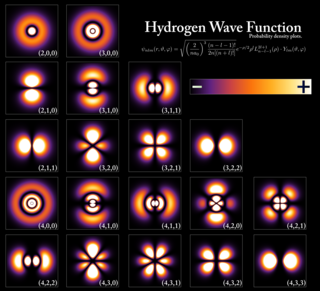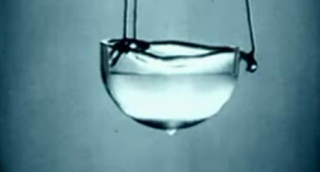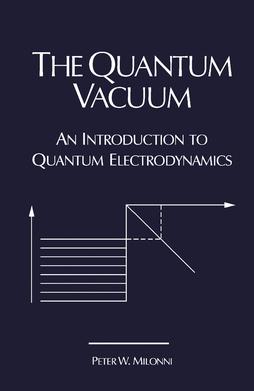
The plum pudding model is one of several historical scientific models of the atom. First proposed by J. J. Thomson in 1904 soon after the discovery of the electron, but before the discovery of the atomic nucleus, the model tried to account for two properties of atoms then known: that electrons are negatively charged subatomic particles and that atoms have no net electric charge. The plum pudding model has electrons surrounded by a volume of positive charge, like negatively charged "plums" embedded in a positively charged "pudding".

Quantum mechanics is a fundamental theory in physics that describes the behavior of nature at and below the scale of atoms. It is the foundation of all quantum physics, which includes quantum chemistry, quantum field theory, quantum technology, and quantum information science.
Spontaneous emission is the process in which a quantum mechanical system transits from an excited energy state to a lower energy state and emits a quantized amount of energy in the form of a photon. Spontaneous emission is ultimately responsible for most of the light we see all around us; it is so ubiquitous that there are many names given to what is essentially the same process. If atoms are excited by some means other than heating, the spontaneous emission is called luminescence. For example, fireflies are luminescent. And there are different forms of luminescence depending on how excited atoms are produced. If the excitation is effected by the absorption of radiation the spontaneous emission is called fluorescence. Sometimes molecules have a metastable level and continue to fluoresce long after the exciting radiation is turned off; this is called phosphorescence. Figurines that glow in the dark are phosphorescent. Lasers start via spontaneous emission, then during continuous operation work by stimulated emission.

In cosmology, the cosmological constant, alternatively called Einstein's cosmological constant, is the constant coefficient of a term that Albert Einstein temporarily added to his field equations of general relativity. He later removed it, however much later it was revived and reinterpreted as the energy density of space, or vacuum energy, that arises in quantum mechanics. It is closely associated with the concept of dark energy.
In quantum mechanics, wave function collapse, also called reduction of the state vector, occurs when a wave function—initially in a superposition of several eigenstates—reduces to a single eigenstate due to interaction with the external world. This interaction is called an observation, and is the essence of a measurement in quantum mechanics, which connects the wave function with classical observables such as position and momentum. Collapse is one of the two processes by which quantum systems evolve in time; the other is the continuous evolution governed by the Schrödinger equation.

Zero-point energy (ZPE) is the lowest possible energy that a quantum mechanical system may have. Unlike in classical mechanics, quantum systems constantly fluctuate in their lowest energy state as described by the Heisenberg uncertainty principle. Therefore, even at absolute zero, atoms and molecules retain some vibrational motion. Apart from atoms and molecules, the empty space of the vacuum also has these properties. According to quantum field theory, the universe can be thought of not as isolated particles but continuous fluctuating fields: matter fields, whose quanta are fermions, and force fields, whose quanta are bosons. All these fields have zero-point energy. These fluctuating zero-point fields lead to a kind of reintroduction of an aether in physics since some systems can detect the existence of this energy. However, this aether cannot be thought of as a physical medium if it is to be Lorentz invariant such that there is no contradiction with Einstein's theory of special relativity.
The transactional interpretation of quantum mechanics (TIQM) takes the wave function of the standard quantum formalism, and its complex conjugate, to be retarded and advanced waves that form a quantum interaction as a Wheeler–Feynman handshake or transaction. It was first proposed in 1986 by John G. Cramer, who argues that it helps in developing intuition for quantum processes. He also suggests that it avoids the philosophical problems with the Copenhagen interpretation and the role of the observer, and also resolves various quantum paradoxes. TIQM formed a minor plot point in his science fiction novel Einstein's Bridge.

In quantum field theory, the quantum vacuum state is the quantum state with the lowest possible energy. Generally, it contains no physical particles. The term zero-point field is sometimes used as a synonym for the vacuum state of a quantized field which is completely individual.
The Abraham–Minkowski controversy is a physics debate concerning electromagnetic momentum within dielectric media. Two equations were first suggested by Hermann Minkowski (1908) and Max Abraham (1909) for this momentum. They predict different values, from which the name of the controversy derives. Experimental support has been claimed for both.
Stochastic electrodynamics (SED) is extends classical electrodynamics (CED) of theoretical physics by adding the hypothesis of a classical Lorentz invariant radiation field having statistical properties similar to that of the electromagnetic zero-point field (ZPF) of quantum electrodynamics (QED).
Federico Capasso is an applied physicist and is one of the inventors of the quantum cascade laser during his work at Bell Laboratories. He is currently on the faculty of Harvard University.
PVLAS aims to carry out a test of quantum electrodynamics and possibly detect dark matter at the Department of Physics and National Institute of Nuclear Physics in Ferrara, Italy. It searches for vacuum polarization causing nonlinear optical behavior in magnetic fields. Experiments began in 2001 at the INFN Laboratory in Legnaro and continue today with new equipment.

Jonathan P. Dowling was an Irish-American researcher and professor in theoretical physics, known for his work on quantum technology, particularly for exploiting quantum entanglement for applications to quantum metrology, quantum sensing, and quantum imaging.

cGh physics refers to the historical attempts in physics to unify relativity, gravitation and quantum mechanics, in particular following the ideas of Matvei Petrovich Bronstein and George Gamow. The letters are the standard symbols for the speed of light (c), the gravitational constant (G), and the Planck constant (h).

Peter Heszler was a Hungarian physicist. He is well known for, among others, his research on laser-assisted nanoparticle synthesis. His research included nanotechnology, condensed matter physics, materials science, fluctuations and noise, laser science and chemical sensors, including fluctuation-enhanced sensing.
Gerhart Lüders was a German theoretical physicist who worked mainly in quantum field theory and was well known for the discovery and a general proof of the CPT theorem. This theorem is also called the Pauli-Lüders theorem and is one of the most fundamental rules of particle physics.

The QED vacuum or quantum electrodynamic vacuum is the field-theoretic vacuum of quantum electrodynamics. It is the lowest energy state of the electromagnetic field when the fields are quantized. When Planck's constant is hypothetically allowed to approach zero, QED vacuum is converted to classical vacuum, which is to say, the vacuum of classical electromagnetism.
The entropy of entanglement is a measure of the degree of quantum entanglement between two subsystems constituting a two-part composite quantum system. Given a pure bipartite quantum state of the composite system, it is possible to obtain a reduced density matrix describing knowledge of the state of a subsystem. The entropy of entanglement is the Von Neumann entropy of the reduced density matrix for any of the subsystems. If it is non-zero, i.e. the subsystem is in a mixed state, it indicates the two subsystems are entangled.

The Quantum Vacuum: An Introduction to Quantum Electrodynamics is a physics textbook authored by Peter W. Milonni in 1993. The book provides a careful and thorough treatment of zero-point energy, spontaneous emission, the Casimir, van der Waals forces, Lamb shift and anomalous magnetic moment of the electron at a level of detail not found in other introductory texts to quantum electrodynamics.
David Leslie Andrews,, is a British scientist appointed as Professor of Chemical Physics at the University of East Anglia, where he was the Head of Chemical Sciences and Physics, from 1996 to 1999.









